Do hurricanes raise salinity levels and what happens after the storm is gone? This scientific data reveals the truth.
If you're on social media (and who isn't these days?) then you surely see the same, typical comments from Louisiana locals whenever a tropical storm approaches:
"This ought to give Lake Pontchartrain a good flushing"
or
"This will get salinity levels up and really kick off the fall fishing"
But is this really the case?
I always thought so, until I began paying closer attention to how water moves through the marsh.
That's when I started asking questions.
Do hurricanes raise salinity like we think they do?
I don't think anybody is willing to argue that point. Of course hurricanes raise salinity levels!
Quite obviously, tropical storms and hurricanes push water from the salty Gulf of America into our interior (and less salty) marshes in the form of storm surge.
This storm surge can be devastating, hastening coastal erosion and destroying homes and businesses.
But, sometimes all it does is raise water levels and – consequently – salinity.
You really only need to taste the water to know for sure, but you can detect this rise in salinity much easier using a simple tool.
How To Read Salinity Levels Across Louisiana's Coast
The National Water Information System (NWIS) is an online information resource hosted by the U.S. Geological Survey (USGS).
It allows you to access data for various metrics across USGS stations such as water level, water temperature, and salinity.
It's a pretty cool tool to use to monitor the effect of tropical storms and hurricanes on salinity levels, and helps us detect the rise in salinity associated with storm surge.
But what happens once the storm is gone?
Do salinity levels remain elevated after storm surge?
This is the million dollar question, and we will use USGS NWIS to get our million dollar answer.
We will begin by looking at salinity levels before, during and after the following storms:
- 2012 Hurricane Isaac
- 2017 Hurricane Nate
- 2020 Hurricane Laura
2012 Hurricane Isaac's effect on salinity
Hurricane Isaac made landfall on Louisiana's coast August 28th, 2012.
Below you will see how hurricanes raise salinity for two USGS NWIS stations that I check when judging conditions for speckled trout and redfish.
These are the Rigolets Pass (located at 30°10'01" N 89°44'26" W ) and Bay Gardene ( 29°35'08.7" N 89°36'21.5" W ).
I've also selected these because they sit on salinity boundaries between the Gulf of America and freshwater input from the Mississippi River.
Rigolets Pass
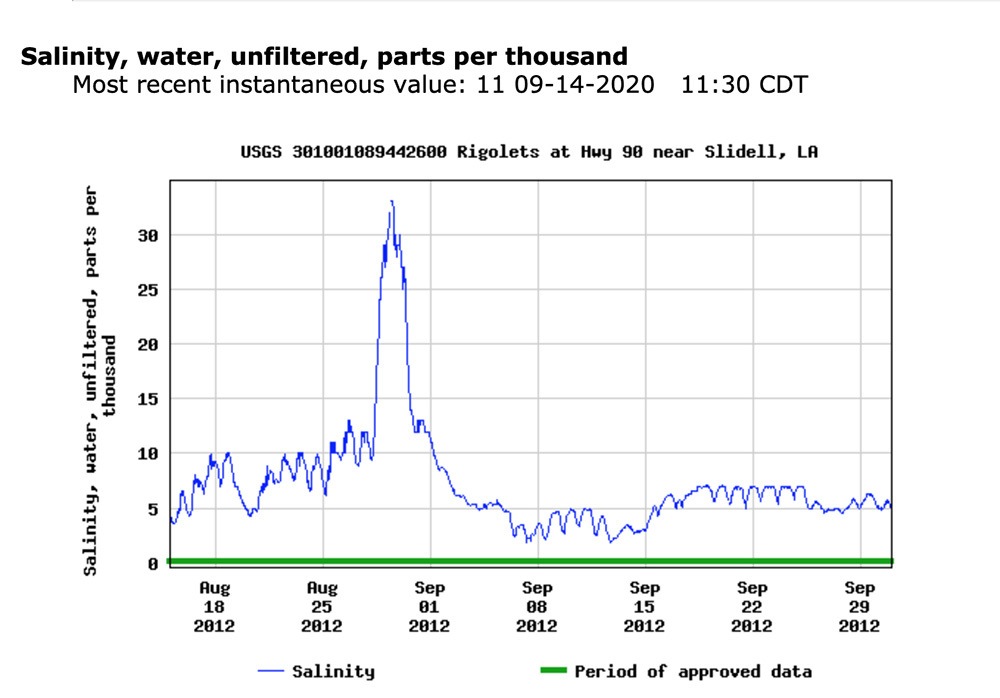
As you can see, the salinity spikes up when Hurricane Isaac hits then proceeds to return to where it was before!
We see very much the same phenomenon for Bay Gardene.
Bay Gardene
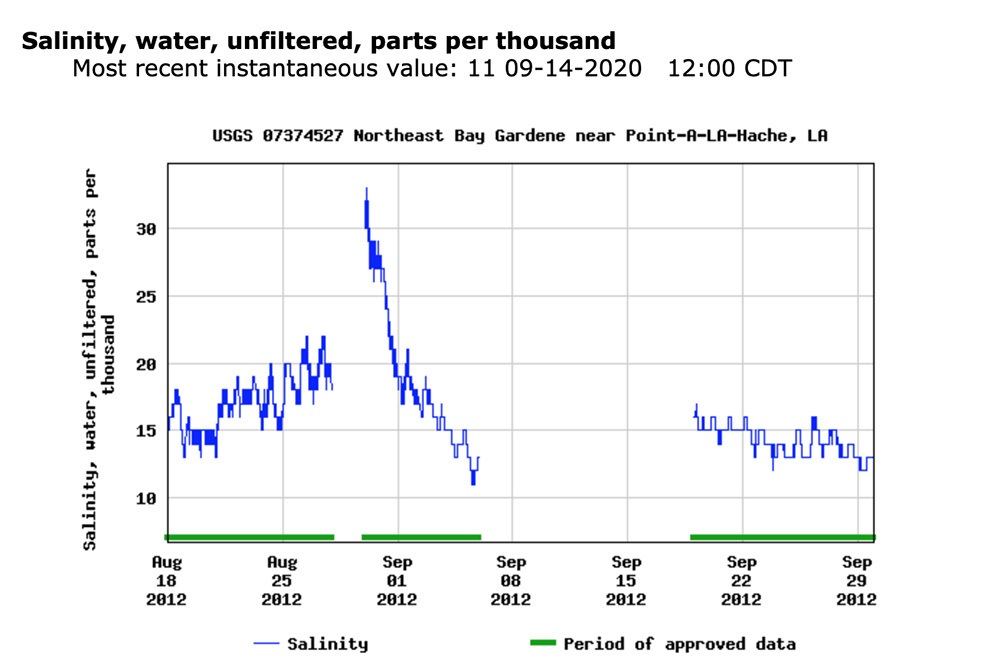
While there is a period of time that the station was not transmitting data (this is a regular occurrence) you can see very plainly that the salinity level spiked with the arrival of Issac, then returned to where it was before.
It's very obvious that salinity levels do not remain high once the storm surge pushes them there, instead they go up then go back down.
But is this a fluke? A one time thing? Let's look at a couple other storms to see if there is a pattern.
2017 Hurricane Nate's effect on salinity
Hurricane Nate made landfall near the mouth of the Mississippi River on October 8th, 2017.
Again, we are looking at the USGS NWIS stations at Rigolets Pass and Bay Gardene:
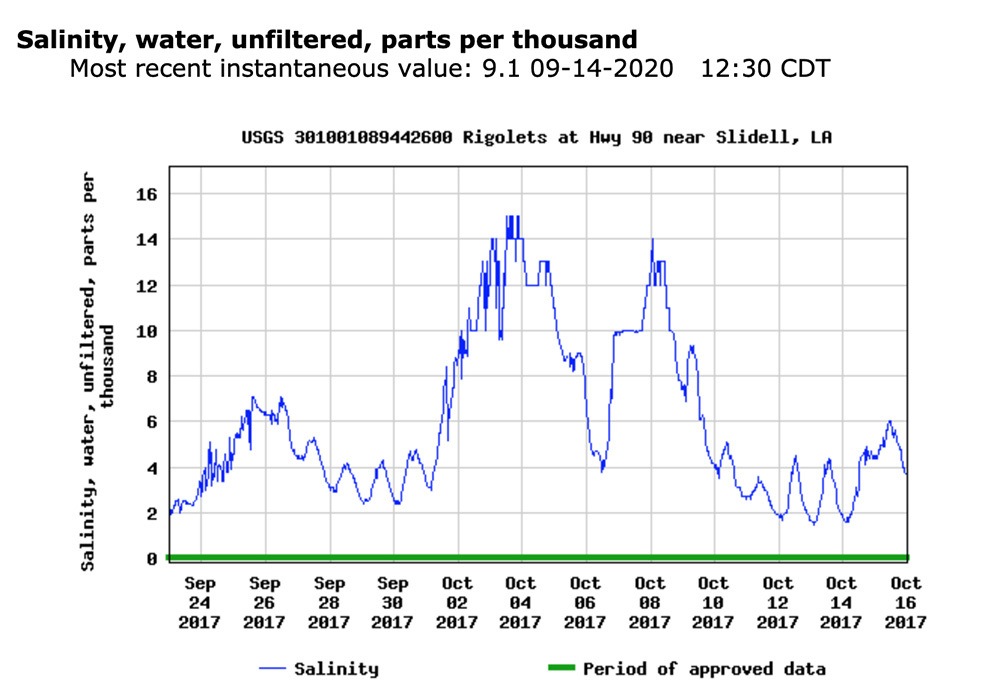
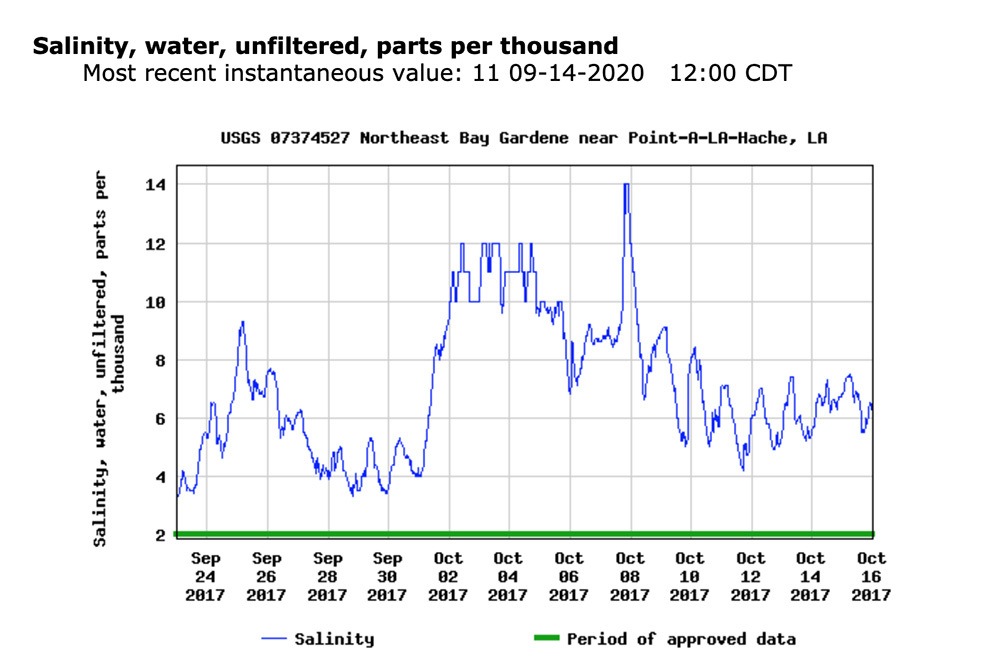
We see the same trend in 2017 with Hurricane Nate as we did in 2012 with Hurricane Isaac: the salinity level goes up then promptly returns once the storm is over.
Just to be sure, let's look at 2020's Hurricane Laura.
2020 Hurricane Laura
Unlike the two previous storms covered in this blog post, Hurricane Laura hit not the east side of Louisiana, but the west side.
However, her scale and power was enough to affect the east side with storm surge worthy of consideration.
She made landfall near Cameron, Louisiana on August 27th, 2020.
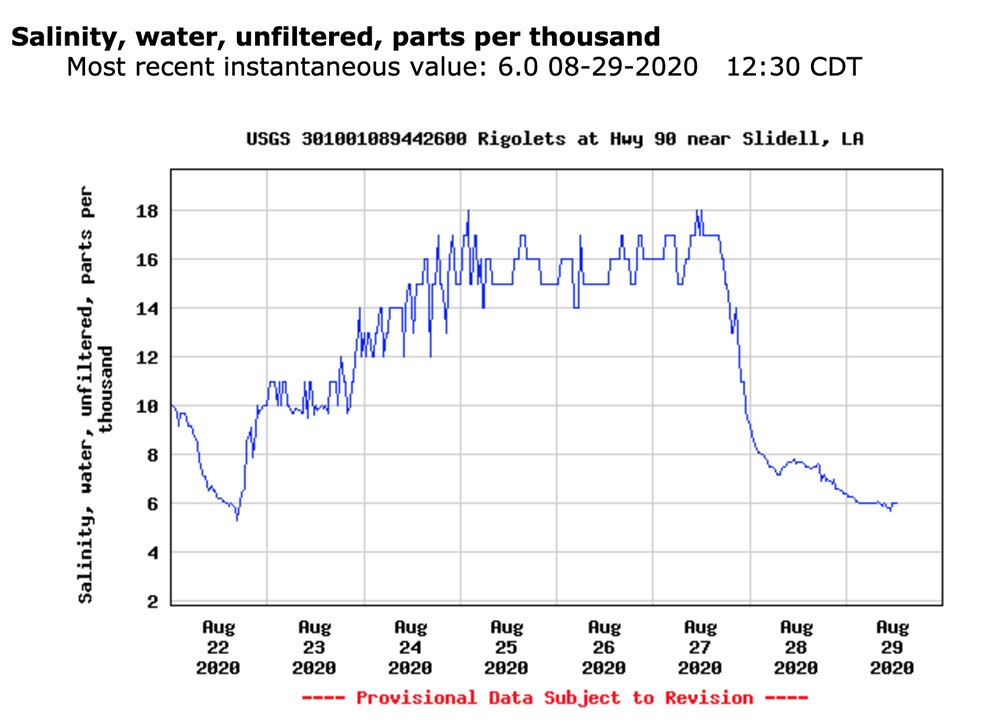
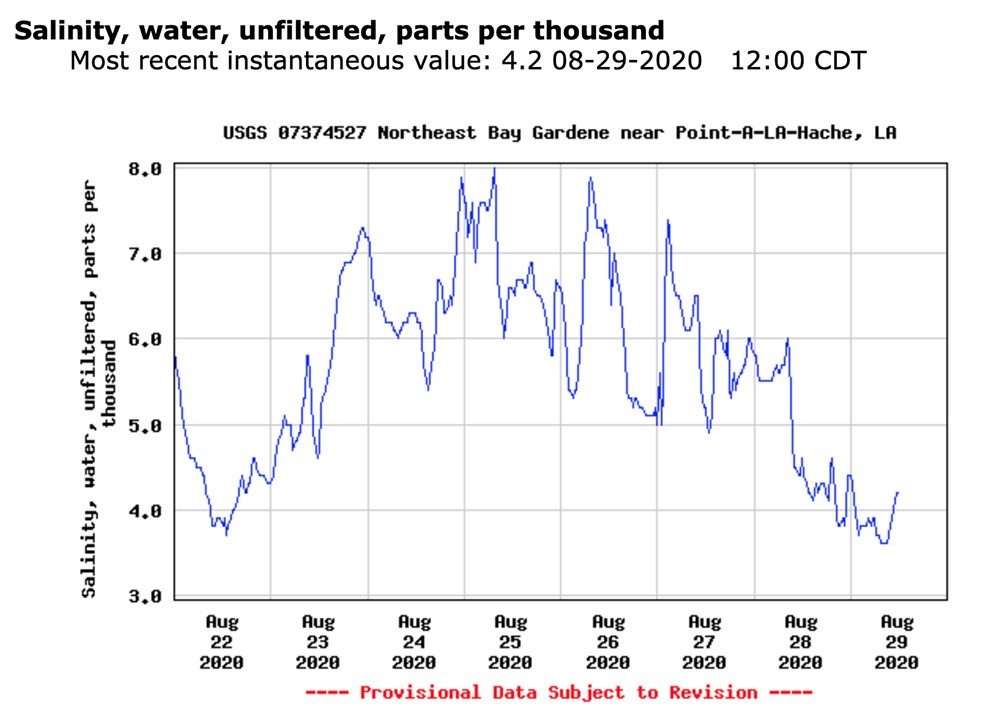
I think it's obvious at this point in time that we can expect salinity to return to its pre-storm levels and that there is no "flushing" occurring.
In fact, I've checked salinity levels west of the Mississippi River as well as during other storms and they've all checked out to be the same.
Nowhere could I find an instance where a storm raised the salinity of an estuary for a period of time longer than what the storm lasted.
Why does salinity return to pre-storm levels?
I'm no marine biologist (or scientist of any kind) but I do use resources like USGS NWIS to better understand the marsh and, of course, catch speckled trout and redfish.
From my observations over years of inshore fishing, it's my SWAG (a fancy acronym for "scientific wild ass guess") that the wind of a tropical storm does what wind in any weather system does: temporarily displaces water.
As soon as the wind stops blowing, the water goes back to where it was.
So, the salty water gets pushed in by the Gulf, which pushes the less salty water (that was previously there) further inland (i.e. your home) and, once the storm dissipates, the saltier water returns to the Gulf and the water that was further inland (or your living room) returns to where it was.
What does this mean for inshore fishing?
I think it depends on the time of year, what the fish are doing and what happens to other important fishing conditions like water levels.
For example, storm surge in July is different for speckled trout than storm surge in October, because during July the trout are spawning and during October they are found feeding heavily on white shrimp.
We know that specks seek higher salinity to spawn, but I doubt that just because there's a temporary spike in salinity lasting a few days that they are going to move inland for the rest of the year.
During the fall storm surge could push them in faster (since salinity is no longer as important as it was during the spawn) and accelerate the white shrimp migration.
Salinity Isn't That Important Anyway
I think that some folks in Louisiana put more weight on salinity than what it's worth.
This article explains how well redfish do in freshwater, and this other article breaks down the near-fresh water we catch speckled trout in when it's not spawning season.
Want To Learn More?
Tools like NWIS and more are what I use to determine the best time and place to cast a line for speckled trout and redfish.
You can watch exactly how I use these resources and more inside my membership, LAFB Elite

As long as we are all catching, I am fine! lol Everything’s great when we’re all catching. Thanks for commenting, Bob.
Thanks for watching, Farris! I can’t speak much for Florida, as I’ve only fished there a few times, but I imagine the dynamic there can’t be a whole lot different from what we have here.
In fact, I’d love to see a salinity map around some of the major rivers in Florida. That’d be really interesting.
I think the cloud cover helps drop the water temp. It was during Harvey in 2017 we saw a temp drop so significant that it had cold front like effects on the fish.
I’ve been watching several buoy sites in the Biloxi area. As expected the salinity is on the rise right now, but more interesting is that water temps are down from the upper eighties to the lower eighties. Going to have to see how much they rebound after the storm passes if at all.
I live in Shalimar Fl. on Garnier’s bayou, just a few miles from East Pass in Destin. Been fishing here 50+ years. One thing I have noticed by watching the tide lines, there is very little mixing of the clean, high salinity water of the gulf with the dirtier, lower salinity water of the bays and bayous on an average day. I’m sure when we get a storm that disrupts the gulf there is probably more mixing but as the storm abates the water and the tide lines return to normal. Thanks for the scientific info. I think it backs what we have known for years . I really enjoyed your analysis.
I never worried about salinity for fall / winter fishing . I do know that a storm in early / mid fall seems to make for a more productive winter trout trip on the La. 1 corridor.